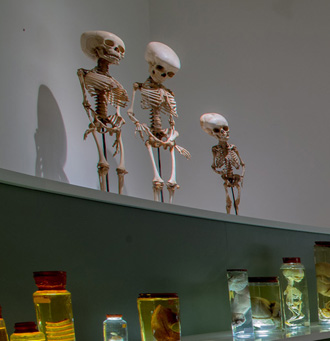
Real human bodies
A fascination with the macabre
The tradition goes bacck to Frederik Ruysch. This famous seventeenth-century anatomist invited people into his house every weekend. Hundreds of people came to gape at babies in formaldehyde, sawed-open skulls, and muscles on display. His specimens were so well-treated that people sometimes forgot the bodies were dead. In fact, when tsar Peter the Great visited his house, he couldn’t help himself – he picked up the mounted head of a child and kissed it.
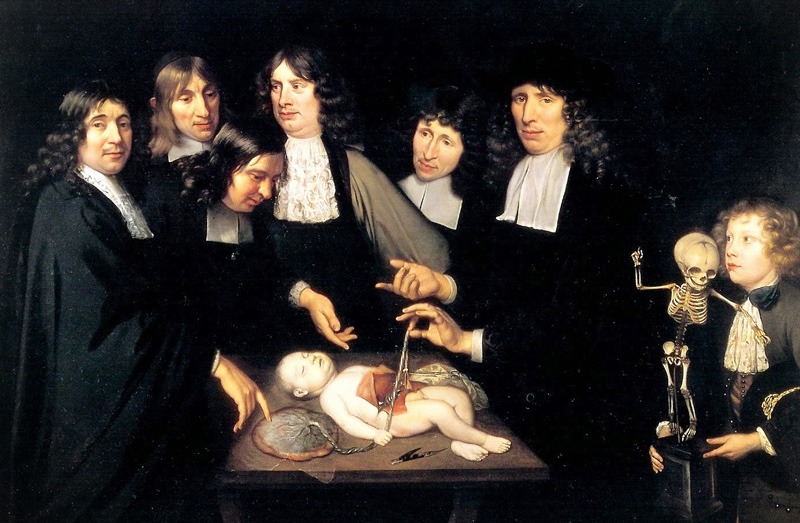
Frederik Ruysch’ Anatomical lesson by Jan van Neck, 1683, in the collection at the Amsterdam Museum.
But Ruysch was careful, respectful. He would usually push the more gruesome specimens, such as deformed babies, to the back of the shelves so they would be less conspicuous. Whenever a small child’s genitalia were visible, he turned them away from the audience, for the sake of propriety.
Gaping
It’s a different story for the modern anatomy exhibitions which have become so popular. These exhibits gained traction when German anatomist Gunther von Hagens developed a technique to replaces water and fat with silicone, preserving bodies indefinitely. Von Hagens then displayed dozens of bodies in various positions: a rider on a horse, or a variation of Rodin’s thinker. Some people felt it was gruesome and disrespectful, while others thought it was amazing and educational.
Von Hagens’ exhibition Körperwelten was replicated by others, including Real Human Bodies, which people can now view at the old Sugar Factory. A like the exhibits hundreds of years ago, Real Human Bodies will draw in thousands of people who have come to gape at the macabre spectacle.
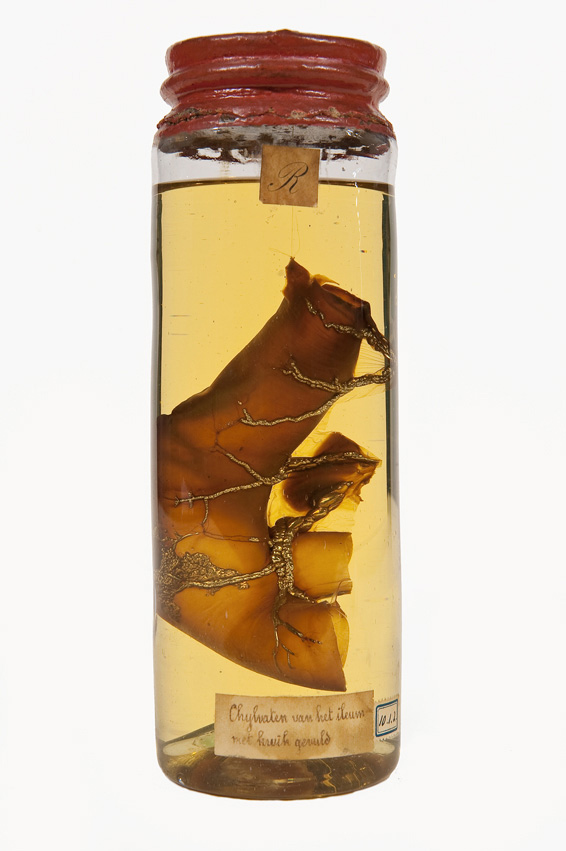
Intestine with mercury
While Ruysch and his successors tried to be respectful, people who visited Körperwelten might have encountered scandal: two bodies posed to look like they were having sex, or a body nailed to a cross like the Christ. ‘That’s a whole different ball game’, says Rina Knoeff, who has studied anatomical specimens for years. ‘Kind of pornographic, really.’
It’s interesting that Knoeff is uncomfortable; she has been studying anatomic specimens for almost twenty years. Conjoined twins in a glass jar? An oesophagus, still containing the fish bone that killed its original owner? None of these things bother her.
That is to say, the specimens themselves don’t. But the stories behind them do, along with the thought that these bodies were once people. Take the Siamese twin, for example. ‘Ruysch often had to bargain with parents to obtain such a body. In one case, the parents only agreed on the condition that they could come see the body whenever they wanted and that they would get it back if Ruysch should die before them.’
Pomp and circumstance
In other words: these specimens weren’t just for pomp and circumstance. They also gave bereaved parents a tie to their dead children – not unlike visiting a loved one’s grave.
In those days, anatomists like Ruysch and his famous successors Albinus in Utrecht and Pieter de Riemer, whose specimens are on display at the University Museum in Groningen, did their utmost to present the specimens tastefully.
Sometimes, they turned them into veritable pieces of art, replete with references. There is a young child’s arm on display at the UM; it holds a leaf tenderly between its fingers. ‘It symbolises the medical world view that everything in nature, including the human body, consists of increasingly smaller vessels, just like in a leaf’, says Knoeff. The arm is encased in a lace cuff, hiding the ugly end where it was cut off.
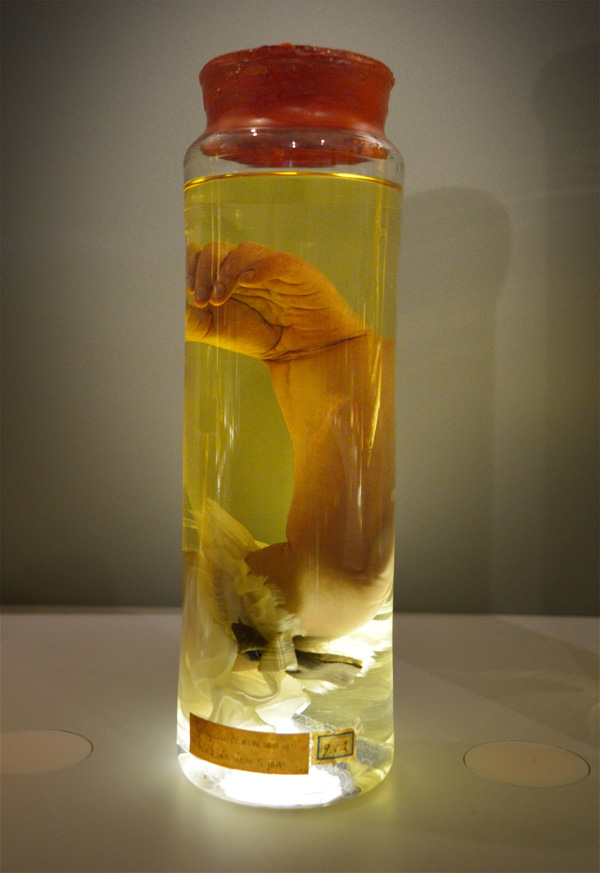
Arm in lace cuff to hide where it was cut off
Another beautiful example on display at the UM is a collection of lymph nodes filled with mercury. On the one hand, mercury was chosen because its small particles easily penetrate the gossamer lymph vessels, making them perfectly visible. ‘But in alchemy, mercury was also known as the element of life’, says Knoeff. ‘So it wasn’t a coincidence that they chose that particular substance.’
Mortality
The specimens from Körperwelten or Real Human Bodies are much less surprising, says Knoeff. ‘They’re more like dolls, really’, she says. ‘They don’t quite confront people with their own mortality.’
Nevertheless, these exhibitions continue a tradition in their own way. Ruysch, Albinus, De Riemer: all were travellers on a scientific journeys of discovery. Blood vessel by blood vessel, they uncovered the inner workings of the human body. They used their specimens to share that knowledge with colleagues, doctors, students, and the ever-curious public audience.
Knoeff chuckles. ‘This one time, Ruysch stuffed a penis. This was quite the accomplishment, since the penis was considered the most difficult body part to stuff. It was the centre piece of the collection.’ But in all the hubbub of the exhibit, someone managed to make off with the penis. ‘Ruysch thought it may have been a competitor of his who wanted to figure out how he’d done it. In those days it was a big secret.’
Ruysch even went so far as to proclaim that his specimens were better than ordinary corpses for educational training, Knoeff says. The body’s natural putrefaction during dissection means things are constantly changing, but his process halted that decay. ‘He even performed public dissections in August, the warmest month of the year; these usually only took place during winter because the stench would otherwise be unbearable.’
Idealised image
The Real Human Bodies exhibition also tries to emphasise learning: the specimens in the show are also used for medical training, they say. It’s the best way to learn how the human body is put together. The specimens clearly display the effects of cancer, AIDS, and smoking.

Skeletons of children in a ball pit by Wim T. Schippers
And there is an underlying message to the exhibition: the method, which replaces all the body fat, results in tight bodies which are often posed as though engaged in sports. ‘They represent an idealised image’, Knoeff thinks. ‘They convey a message of healthy living and the ideal body.’
But Knoeff doesn’t think it’s the message that will draw people to the exhibition. People will come because they are fascinated with life after death – because of the very human desire to understand what is left of us, in the end. We tend to think of dead bodies as sacred, as something separate from the living. But an exhibition like this puts the dead among the living.
‘Remember how Wim T. Schippers once posed children’s skeleton’s in a ball pit at the UM?’, Knoeff says. ‘There’s an excitement there.’
Morbid fascination
And then there is that hunger for the macabre – that morbid fascination with anything strange or different. ‘Like how people used to go to the fair to see a giant, or a midget, or conjoined twins’, Knoeff says.
Whenever she goes to the UM with her students to see the anatomical collection, it’s the monstrosities – the deformed children – that draw the most attention. Knoeff herself is less fascinated with these specimens. ‘I tend to see the story and the context behind them. In the end, I mainly think they’re sad.’
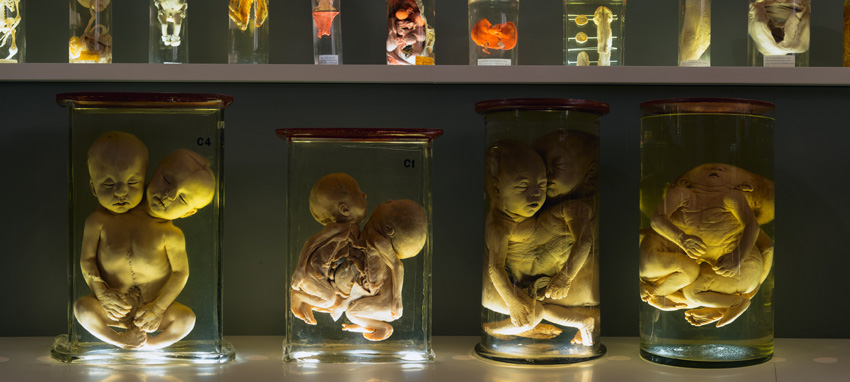
Monstrosities: the collection of deformed children
The Real Human Bodies exhibition will be held at the former Sugar Factory from 12 to 15 April. Admission is 15 euros, 10 for students.
The anatomical collection at the UM can be seen every week from Tuesday to Sunday, between 1 and 5 p.m. Admission is free.

